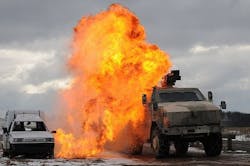Military reaches out to industry for ways to respond quickly to new kinds of improvised threats
Officials of the Army Contracting Command in Natick, Mass., issued a sources-sought notice this week (W911QY-16-R-ITIR) to develop a quick-reaction capability to respond to unanticipated improvised threats from terrorists or other adversaries.
Improvised threats involves roadside bombs and other improvised explosive devices (IEDs), but encompass much more than IEDs, Army officials say.
Improvised threats involve inexpensive and readily available technologies that U.S. and allied adversaries use to counter technological advantages of the U.S. military. They pertain to cheaply available technologies, tactics, techniques that enemies can transform into lethal weapons. Suicide bombers are one example of this.
Related: Not your old timer's electronic warfare
The U.S. military's focal point for responding quickly to improvised threats is the Joint Improvised-Threat Defeat Agency (JIDA) -- which is the new name for the organization formerly known as the Joint Improvised Explosive Device Defeat Organization (JIEDDO). The organization was renamed last summer to represent an expansion of its mission.
JIDA's new mission includes the IED threat, as well as new improvised threats like tunnel operations and weaponized flying drones. Like its JIEDDO predecessor, JIDA's goal is to be as adaptive and innovative in defeating these threats as adversaries are at implementing and evolving them.
Topping the JIDA's technological wish list are synthetic aperture radar (SAR) technologies that are small, lightweight, and power-efficient; small, lightweight, and power-efficient multi-spectral, hyperspectral, near-infrared, shortwave infrared, and long-wave infrared sensors; packaging sensors on small unmanned aerial vehicles (UAVs); and acoustic, seismic, and radar sensors for ground vehicles and aircraft.
Military researchers want the ability to order these kinds of new technologies from industry within 30 to 60 days, and have it ready for battlefield use within one year.
From industry, military researchers want ideas to help craft an acquisition process to help them meet these goals. Researchers envision efforts aimed at countering improved threats, and can include research feasibility studies; prototyping, commercial off the shelf (COTS) procurement, modified COTS technologies; integration; and operational assessment.
Companies interested should email their ideas no later than 5 Nov. 2015 to the military's Shawn Haubner at [email protected].
More information is online at https://www.fbo.gov/notices/6373fb49af0043829cafd052c67d4abf.
